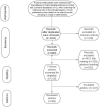Human Papillomavirus-Associated Head and Neck Cancers. Where are We Now? A Systematic Review
- PMID: 36465708
- PMCID: PMC9709860
- DOI: 10.2147/CMAR.S379173
Human Papillomavirus-Associated Head and Neck Cancers. Where are We Now? A Systematic Review
Abstract
Background: Human papillomavirus targets the skin and mucous membranes, producing benign hyperplastic lesions and precancerous and cancerous lesions. An increasing number of head and neck cancersin particular, oropharyngeal squamous cell carcinoma, laryngeal squamous cell carcinoma, and oral squamous cell carcinoma, are attributable to HPV infection. HPV-induced HNCs typically affect younger, nonsmoking patients with no prior history of heavy alcohol use, more extensive sexual history, and higher socioeconomic status.
Aim: The purpose of the review is to present the most recent and well-established findings concerning HPV-induced head and neck cancers and consequently to provide medical specialists with essential information regarding the epidemiology, the role of HPV in HNC cancerogenesis, prevention, diagnosis, and treatment.
Material and methods: All authors independently have searched The EMbase, Medline/Pubmed, and Cochrane databases by using the following keywords "head and neck cancer", "human papillomavirus", "HPV", "HPV biology", "oropharyngeal squamous cell carcinoma", "carcinogenesis", "transoral surgery", "robotic surgery". The last search was conducted in March 2022. The references of the publications of interest were also screened for relevant papers. There were no limitations in regard to the publication date.
Conclusion: Aiming to avoid the epidemic of HPV-induced HNC, it is paramount to improve the access to vaccination as well as resolve parental concerns regarding vaccine safety. Physicians should rely on reduced-dose radiation and aim to reduce the overall treatment time. Thanks to a more elaborate understanding of the genomic background of HPV-induced HNC, precision medicine could become a relevant part of patients' management. In comparison to traditional techniques and non-operative treatment, transoral robotic surgery (TORS) offers similar oncologic and functional outcomes, with a possible benefit on long-term quality of life. However, more research is needed to establish clear guidelines indicating when TORS resections should be supported with adjuvant therapy.
Keywords: HPV; HPV biology; carcinogenesis; head and neck cancer; human papillomavirus; oropharyngeal squamous cell carcinoma; robotic surgery; transoral surgery.
© 2022 Pinkiewicz et al.
Conflict of interest statement
The authors declare that they have no competing interests and received no funding.
Figures


References
-
- Hashibe M, Brennan P, Chuang SC, et al. Interaction between tobacco and alcohol use and the risk of head and neck cancer: pooled analysis in the International Head and Neck Cancer Epidemiology Consortium. Cancer Epidemiol Biomarkers Prev. 2009;18(2):541–550. PMID: 19190158; PMCID: PMC3051410. doi:10.1158/1055-9965.EPI-08-0347 - DOI - PMC - PubMed
Publication types
LinkOut - more resources
Full Text Sources

